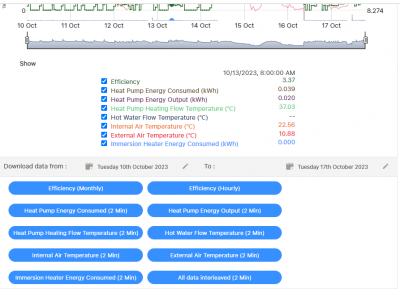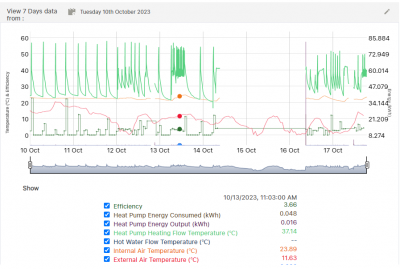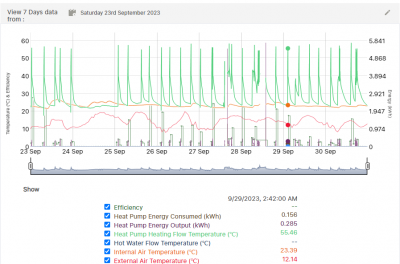Posted by: @iancalderbankjust did a quick google: is passiving something that does online monitoring of your system via data from the heat meter? I'd be interested to see any output from that system. Not just because of your system, but more because I am interested in heat pump monitoring systems.
Yes, it came with the system, I'll post some screenshots below. One of the many problems with this install was the installer put in powerline plugs to send the data to my router. They haven't worked well at all, so if you see gaps in my data that is why. As it happens I've replaced them with a wireless set up just this afternoon and that is working well so far.
22mm at that point would seem reasonable for your number of radiators. does this go to all the radiators, or is there another 22mm branch going to another floor?
No other floors. My ground floor is concrete floored. All the radiator pipes are under the 1st floor floorboards. Judging by how the radiators warm up it seems to be a clockwise loop when looking from above.
Posted by: @riponowlThe system is heating my house satisfactorily with efficiency of around 3.5 (if I can believe Passivliving).
A COP of 3.5 is pretty good in my opinion. I now have a similar system since my buffer tank was removed, but I also have had 2 Honeywell valves changed for one 3 way valve (Sintesi Comparato) and the mag filter removed. My COP is much lower than that - around 3.0. Also, your indoor temperature is higher and your flow temperature is lower (in part due to your lower heat loss calc), so I believe you are doing pretty well and I don't think you should rush to change anything. Of course, the COP figure is heavily dependent on accurate flow readings and whether the Sontex is calibrated for the presence of glycol, which I doubt. Ultimately, the important figures are the warmth of the house and the kWh required to keep it so. My impression is that my house is warmer since the changes without much change in kWh.
Posted by: @iancalderbankIt is quite likely that the reason you have two pumps is because your system needs an awful lot of pump head (i.e. "push") because of the aperture size constraints in the filter and zone valve components. Thus your pumps are running flat out, and there are two of them, so they are noisy.
I think that Freedom Heat Pumps, who will have supplied this Samsung always recommend two water pumps, even when a buffer tank is not present. The following is an extract from page 11 of Samsung ASHP Installation and Maintenance Manual With Pre-Plumbed Cylinders (see attached)
This relay configuration will ensure that the secondary pump runs whenever the primary pump runs AND the heating valve is open,
ensuring that the system has the required minimum circulating water volume, without the use of large, expensive buffers or volumizers,
and access to the secondary side when in defrost mode.
If the combined system volume of the primary + secondary circuit is less than 30l for a 5Kw or less than 50l for an 8Kw, 12Kw and 16Kw,
you will still need a volumizer of buffer.
Typically, will not be an issue unless working on a very small house/flat with less than 5 radiators or below 60m 2 floor area.
Posted by: @mike-hI think that Freedom Heat Pumps, who will have supplied this Samsung always recommend two water pumps, even when a buffer tank is not present. The following is an extract from page 11 of Samsung ASHP Installation and Maintenance Manual With Pre-Plumbed Cylinders (see attached)
sorry mike, I disagree
if the system is split primary/secondary, with a buffer or LLH, then you have to have two pumps, it can't work without, thats clear. freedom are talking about a split primary/secondary system in that document, as per diagram page 5.
With a single loop as per the OP's system a single pump should be the design target, works for almost all domestic premises, and is generally accepted as the "most efficient way" to do a heat pump install nowadays.
in the OP's diagram both pumps are driving the same, single loop. The only reason for a second pump in a single loop is if its overly lossy and two pump's worth of head is needed.
My octopus signup link https://share.octopus.energy/ebony-deer-230
210m2 house, Samsung 16kw Gen6 ASHP Self installed: Single circulation loop , PWM modulating pump.
My public ASHP stats: https://heatpumpmonitor.org/system/view?id=45
11.9kWp of PV
41kWh of Battery storage (3x Powerwall 2)
2x BEVs
@riponowl couple of questions about the data from the passivliving screenshots, to me they seem puzzling in a several places.
- they show your flow temperature going up to 60C very frequently, do I read it right? are those DHW heating cycles, or is that normal CH running? 60C is very hot for CH. that could imply that the flow temperature settings on your system are not ideal.
- the efficiency says 3.5 (ish), but the energy consumed is more than the energy output? That would imply efficiency of less than 1.
- the actual energy consumed / output figures seem very low - 0.048 kwh is 48watt hours - which would be no more than a minute or so of usage if the system was running at (e.g) 3kw. Over what time period are the values you are showing calculated?
I appreciate that you say you have gaps in the data due to comms problems, but if you've fixed that now, could you show the figures for perhaps 6-12 hrs worth when the heating is running?
My octopus signup link https://share.octopus.energy/ebony-deer-230
210m2 house, Samsung 16kw Gen6 ASHP Self installed: Single circulation loop , PWM modulating pump.
My public ASHP stats: https://heatpumpmonitor.org/system/view?id=45
11.9kWp of PV
41kWh of Battery storage (3x Powerwall 2)
2x BEVs
Posted by: @iancalderbank@riponowl couple of questions about the data from the passivliving screenshots, to me they seem puzzling in a several places.
- they show your flow temperature going up to 60C very frequently, do I read it right? are those DHW heating cycles, or is that normal CH running? 60C is very hot for CH. that could imply that the flow temperature settings on your system are not ideal.
- the efficiency says 3.5 (ish), but the energy consumed is more than the energy output? That would imply efficiency of less than 1.
- the actual energy consumed / output figures seem very low - 0.048 kwh is 48watt hours - which would be no more than a minute or so of usage if the system was running at (e.g) 3kw. Over what time period are the values you are showing calculated?
I appreciate that you say you have gaps in the data due to comms problems, but if you've fixed that now, could you show the figures for perhaps 6-12 hrs worth when the heating is running?
Yes, it does seem to jump up to 58ish. In September my heating was off and graph is the same, so it seems like it's the hot water spiking up every 5 hours or so, even during the night. I believe it reheats when it drops 5c below the target which would suggest my tank is losing around 1c per hour. That seems a lot. is that what you would expect?
See the graph below. The Legionella cycle ran on Sunday the 24th so that explains the lack of spikes on that day.
If I move the cursor over the graph it displays the figures for that 2 minute slot (where the dots are), which is what you can see on the screen shots. I'm not sure how much value that is. I'll download some data for you tomorrow which might tell us more.
The heat pump does most of its work between 3:30pm and 9pm that's the period when the Hive thermostat increases the required temp. Here is the data from that period...
Yesterday KWH Used 4.66 KWH Produced 20.13 Efficiency 4.31
Tuesday KWH Used 4.89 KWH Produced 19.79 Efficiency 4.04
Last Wed KWH Used 1.8 KWH Produced 7.92 Efficiency 4.4
The efficiency looks pretty good. If I look at a larger time frame including all hours...
Last 6ish days KWH Used 80.29 KWH Produced 276.8 Efficiency 3.44
Since Jan 2022 (Install) KWH Used 5,730 Produced 20,772 Efficiency 3.62
I also kept an eye on the HW temperature today whilst not running any hot water. It's losing about 0.5c per hour. Is that what you would expect?
so a small loss per hour on an unused HW tank is inevitable, no tank insulation is perfect of course, but 0.5C is a bit high, I'm nearer 0.2C. Have a good "feel" of your pipework around the cylinder, when the heating is not running. there are likely to be pipes that conduct and radiate the DHW tanks' heat .
Insulate those first. Ideally insulate all of them, but prioritise those. Get 28mm economy grey pipe insulation from screwfix, £2 a metre, spend a few hours with a stanley knife and some gaffer tape. This made a big difference to the behaviour of mine.
reheating when it drops by 5C, funnily enough I'm having the same issue myself. I can't figure out which setting stops it doing this, I have set FSV3023 to 30 but it still does it. Easiest workaround is to set a timer so that the DHW can only reheat during X time of day. you'll have to juggle X depending on your usage, is one tank a day enough or do you need a 2nd reheat, only you can work this out. DHW reheat efficiency on the ASHP will always be better if you can start with a cool tank and do a full tank reheat, rather than a top-up. I try to reheat mine it once only , at night, when the electricity is also cheaper, with an ad-hoc manual topup only if needed.
your efficiencies do indeed look reasonable, hourly, daily and longer term numbers are the ones to keep an eye on, a 2 minute value for COP is kinda pointless! But, if you can tune out the un-needed DHW reheats you should improve it measurably.
If you are able to rebuild at any point as per our previous discussion, losing the ABV that will get you a tad more as it improves the thermodynamics a bit (by not sending too-hot water back to the HP), and getting head resistance down will enable the circulating pump to run at lower wattage. Is the electricity meter that is hooked to this metering system measuring only the outdoor unit or both the indoor and outdoor? it needs to include the indoor to include the pump power.
the figures look perfectly decent but still a bit inconsistent in terms of the totals . My per-day numbers are roughly double yours in both input and output (we did think your system probably didn't really need a 12kw I think in the discussion at the start?) but my total figure for the last 7 is about the same as yours, which doesn't make sense...
My octopus signup link https://share.octopus.energy/ebony-deer-230
210m2 house, Samsung 16kw Gen6 ASHP Self installed: Single circulation loop , PWM modulating pump.
My public ASHP stats: https://heatpumpmonitor.org/system/view?id=45
11.9kWp of PV
41kWh of Battery storage (3x Powerwall 2)
2x BEVs
Posted by: @riponowlIf I move the cursor over the graph it displays the figures for that 2 minute slot (where the dots are), which is what you can see on the screen shots. I'm not sure how much value that is
I find the display quite helpful, especially if you expand the time scale using the sliders. The energy consumed and energy output figures are measured at 2 minute intervals, so multiplying by 30 gives you the power consumed and outputted at that point in time. Dividing one by the other gives you the COP at that time and it is revealing how COP changes over time after the ASHP starts up. I note that when heating DHW, your flow temperature label is 'Heating Flow Temperature' rather than 'Hot Water Flow Temperature'. This is due to G L not wiring your Eastron SDM630 correctly. I have the same issue, only in reverse! I only have 'Hot Water Flow Temperature' readings whether space heating or DHW heating as the L2 terminal is permanently live. Yours is clearly never live.
@iancalderbank Where do you go to set a reheat timer for the HW? I'll try adding some lagging to the pipework and see if that helps.
I had assumed that KWH used included both the indoor and outdoor equipment, but now you you've got me thinking. Unfortunately there is no way to tell from the wiring as its very difficult to see. I can only think of turning everything in the house off, running the heat pump then comparing the PassivLiving usage to that on my actual meter. That is a job for next week.
Posted by: @mike-hI note that when heating DHW, your flow temperature label is 'Heating Flow Temperature' rather than 'Hot Water Flow Temperature'. This is due to G L not wiring your Eastron SDM630 correctly. I have the same issue, only in reverse! I only have 'Hot Water Flow Temperature' readings whether space heating or DHW heating as the L2 terminal is permanently live. Yours is clearly never live.
Just looking at this again. Do you have a data cable going from your zone valve to your Eastron? Mine zone valves don't have any data cables, the only one I have that goes into the Eastron is from the Sontex. The Sontex has two temp sensor cables and one from the heat meter. As far as I can see there is no way that the Eastron could possibly know which zone is active. It's not incorrectly wired, it's not wired at all.
-
Flow Rate & Low Loss Headers
7 months ago
-
Primary Pump positioning for Samsung Gen6 system
1 year ago
-
Training videos/course/whatever. Control settings
2 years ago
Currently viewing this topic 2 guests.
- 26 Forums
- 2,418 Topics
- 54.8 K Posts
- 374 Online
- 6,098 Members
Join Us!
Worth Watching
Latest Posts
-
RE: Reliable, easy to use home battery options
Happy to help. There are many systems able to provide t...
By Batpred , 2 minutes ago
-

RE: Is my Samsung gen6 outside air temp sensor missing a sheath/sleeve?
@papahuhu The sensor (set back in the tube is surrounde...
By Toodles , 4 minutes ago
-
RE: Ideal HP290 14kW ASHP - how to optimise
@ashp-bobba Many thanks for this - I am doing as advise...
By cmartinbwmba , 6 minutes ago
-

I continue to receive emails from homeowners sharing he...
By Mars , 13 minutes ago
-

RE: Water outage in the the south-east
We think alike @editor ! All those bottles (and I expec...
By Toodles , 15 minutes ago
-

Perhaps I am just a fuss pot - but I am curious too!
With all the talk in the past about reducing ‘distortio...
By Toodles , 1 hour ago
-
RE: Recommended home battery inverters + regulatory matters - help requested
One more earthing question occurs to me. If, as now se...
By JamesPa , 2 hours ago
-

RE: Daikin Wireless Thermostat
@bash We have a Daikin EDLA08 Monobloc standing by our ...
By Toodles , 2 hours ago
-
RE: Installer Fitted 9kW Instead of 11kW Heat Pump and Changed MCS Paperwork - What do I do?
Thats great thanks. TBH setting the low end o...
By JamesPa , 2 hours ago
-

RE: Say hello and introduce yourself
@mrfield, welcome to the forums. Please go here and ...
By Mars , 3 hours ago
-
RE: Ecodan Pump Issues… Circulation pump turns off when heat pump compressor turns off
@ashp-bobba Thanks for the reply. Would it not work ...
By Patch321 , 3 hours ago
-
RE: Octopus Cosy Heat Pump Owners & Discussion Thread
I did not hear back from the tech team. (Assume they ar...
By swwils , 4 hours ago
-
RE: How to use my Hanchu battery storage for home without it feeding back into the grid?
Hi. My Hanchu battery system is controlled by the (Lux...
By SKD , 6 hours ago
-
RE: Advice for a novice on Mitsubishi Ecodan 6kW
In the Home Assistant firmware the data points...
By F1p , 17 hours ago
-
RE: GSHP WOES! Midland based engineer recommendations?
@johnbroome if it is not the pressure in the expansion ...
By ASHP-BOBBA , 18 hours ago
-
So I hear the export MPAN that UKPN assigned should be ...
By Batpred , 21 hours ago
-
RE: New Daikin 11kW Altherma 3M install - is it working as it should?
@toodles Thank you for your input. As the days have got...
By Synthbuilder , 1 day ago
-
RE: Fan unit Making terrible noise HELP!!
@gutoffowc Oh no, sorry to hear that, are you in the Ke...
By ASHP-BOBBA , 1 day ago
-

RE: Sunsynk Whole House Backup Issue
@sheriff-fatman - could you please re-post that in the ...
By Transparent , 1 day ago









